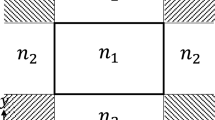Abstract
A Rayleigh approximation is constructed for light scattering by small multilayer axisymmetric particles, in which their polarizability is determined by the generalized separation of variables method (SVM). In this method, scalar potentials, the gradients of which yield the electric-field strengths, are represented as expansions in spherical harmonics of the Laplace equation. Unknown coefficients of expansions are determined from the boundary conditions, which are reduced to infinite systems of linear algebraic equations (ISLAEs), since the separation of variables is incomplete. The T matrix of the electrostatic problem, principal element T11 of which is proportional to the particle polarizability, is determined. The necessary condition for the ISLAEs solvability for the SVM coincides with the condition of the correct application of the extended boundary conditions method (EBCM). However, numerical calculations in which finite-dimensional (i.e., reduced) systems are solved, yield different results in ranges of variation of parameters that are close to the boundary of the range of applicability. An analysis of the numerical calculations of the scattering and absorption cross sections for two-layer confocal spheroids, an exact solution for which can be obtained using spheroidal harmonics, shows that the SVM is preferable to the EBCM. It turned out that the proposed method yields workable results in a wider range of variation of parameters. Even outside the range of applicability, in which it should be regarded as a certain approximate solution, its use in a number of cases is quite acceptable. Additional calculations for three-layer nonconfocal spheroids, as well as for three-layer similar pseudospheroids and Pascal’s snails, which can be obtained from spheroids as a result of the inversion with respect to the coordinate origin and one of the foci, respectively, confirm these inferences. We note that, for certain values of the parameters, the shapes of the latter particles are nonconvex.
Similar content being viewed by others
References
C. Bohren and D. Huffman, Absorption and Scattering of Light by Small Particles (Wiley, New York, 1983).
F. M. Morse and G. Feshbach, Methods of Theoretical Physics (McGraw-Hill, New York, 1953; Inostr. Liter., Moscow, 1960).
L. D. Landau and E. M. Lifshitz, Course of Theoretical Physics, Vol. 8: Electrodynamics of Continuous Media (Nauka, Moscow, 1982; Pergamon, New York, 1984).
V. G. Farafonov, Opt. Spectrosc. 88, 441 (2000).
V. G. Farafonov, Opt. Spectrosc. 90, 574 (2001).
B. Posselt, V. G. Farafonov, V. B. Il’in, and M. S. Prokopjeva, Meas. Sci. Technol. 13, 256 (2002).
V. G. Farafonov, V. I. Ustimov, and M. V. Sokolovskaya, Opt. Spectrosc. 120, 448 (2016).
V. Farafonov, V. Il’in, V. Ustimov, and E. Volkov, Adv. Math. Phys. 2017, 7862462 (2017).
V. G. Farafonov and V. I. Ustimov, Opt. Spectrosc. 122, 282 (2016).
V. G. Farafonov, A. A. Vinokurov, and V. B. Il’in, Opt. Spectrosc. 102, 927 (2007).
V. G. Farafonov, V. Il’in, V. Ustimov, and M. Prokopjeva, J. Quant. Spectrosc. Radiat. Trasfer 178, 176 (2016).
V. G. Farafonov and A. A. Vinokurov, Opt. Spectrosc. 105, 292 (2008).
A. A. Vinokurov, V. G. Farafonov, and V. B. Il’in, J. Quant. Spectrosc. Radiat. Trasfer 110, 1356 (2009).
V. G. Farafonov, Opt. Spectrosc. 117, 923 (2014).
V. G. Farafonov and V. I. Ustimov, Opt. Spectrosc. 119, 1022 (2015).
V. G. Farafonov and V. B. Il’in, J. Quant. Spectrosc. Radiat. Trasfer 146, 244 (2014).
A. G. Kyurkchan and N. I. Smirnova, Mathematical Modeling in Diffraction Theory Based on A Priori Information on the Analytical Properties of the Solution (Media Pabl., Moscow, 2014; Elsevier, Amsterdam, 2015).
V. G. Farafonov and V. B. Il’in, Opt. Spectrosc. 115, 745 (2013).
V. G. Farafonov and M. V. Sokolovskaya, J. Math. Sci. 194, 104 (2013).
V. G. Farafonov and V. I. Ustimov, Opt. Spectrosc. 119, 855 (2015).
V. G. Farafonov and V. I. Ustimov, Opt. Spectrosc. 118, 445 (2015).
Author information
Authors and Affiliations
Corresponding author
Additional information
Original Russian Text © V.G. Farafonov, V.I. Ustimov, 2018, published in Optika i Spektroskopiya, 2018, Vol. 124, No. 2, pp. 255–263.
Rights and permissions
About this article
Cite this article
Farafonov, V.G., Ustimov, V.I. Light Scattering by Small Multilayer Particles: A Generalized Separation of Variables Method. Opt. Spectrosc. 124, 252–261 (2018). https://doi.org/10.1134/S0030400X18020054
Received:
Published:
Issue Date:
DOI: https://doi.org/10.1134/S0030400X18020054




